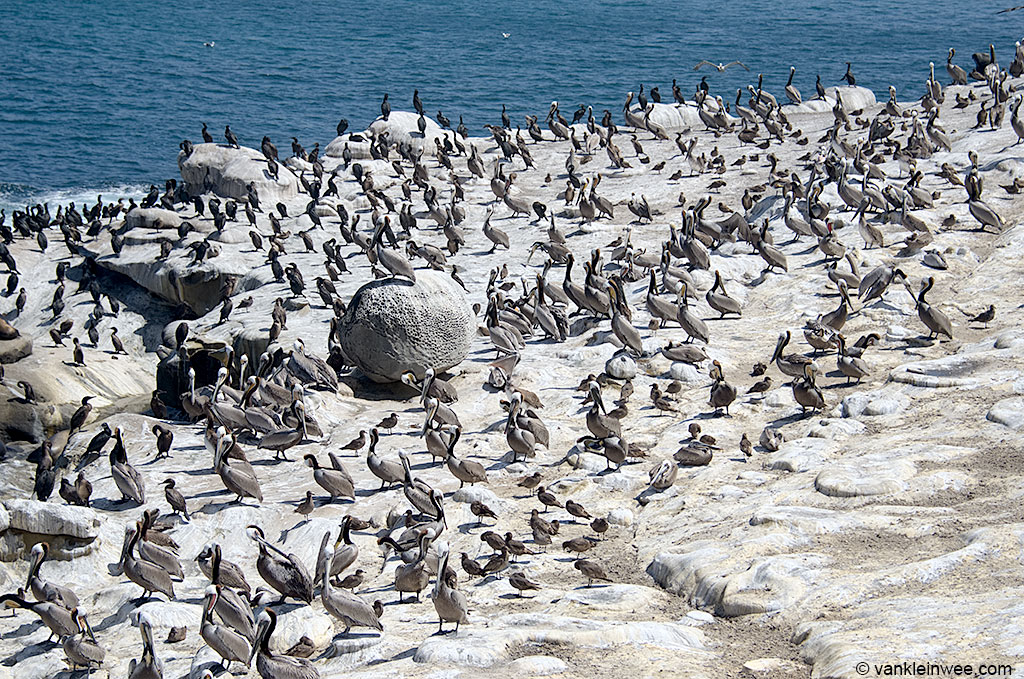When I knew that I was going to visit San Diego in April (see San Diego Trip Reports), my first thought was: I’m going to see Heermann’s Gulls!
Heermann’s Gulls (Larus Heermanni) — and in particular adults in breeding plumage — are high on my list of gulls that I find most beautiful. I was therefore eager to see them “out in the field”.
Low numbers
Even before I set off though I knew that it was going to be a bit of a challenge to see them because at this time of year adults move south to the breeding grounds in Mexico.
And so it proved to be. I have nothing to complain about of course, but the only individuals that I was able to come across were all 2nd-calendar years.
Locations
The first few days of my stay I spent in the Seaport Village area (mainly the area between the Convention Centre and the USS Midway) where only a few Heermann’s Gulls were present.
Later in the week I visited La Jolla (pronounced lə-HOY-ə), where dozens of second-calendar years were present in a large colony of Brown Pelicans and Brandt’s Cormorants.

La Jolla, San Diego, USA, where dozens of second-calendar year Heermann’s Gulls were present. 11 April 2013.

La Jolla, San Diego, California, USA, where dozens of second-calendar year Heermann’s Gulls are present amidst Brown Pelicans and Brandt’s Cormorants. 11 April 2013.
It is actually not surprising to see the Heermann’s Gulls amidst the Brown Pelicans because they are known to actively steel food off of them (known as kleptoparasitism).
I wonder what the pelicans think of their presence at La Jolla, knowing that they will be harassed by them once they start foraging out on the ocean…
Second-calendar years
Heermann’s Gulls of this age have a strikingly dark chocalately-brown plumage, which includes their belly, breast and head. This gives them a very dark overall appearance, something that we don’t see in the gulls that we have in Europe.
Molt pattern
All individuals were in active molt to second basic plumage and had dropped the inner primaries (at least P1, sometimes up to P3).
Some already started to show white feathering on their heads, as can be seen in this individual:
One individual showed all inner primaries still present, but had the center tail feathers replaced by second-generation feathers. I think that this is more to do with replacing feathers that were lost due to some accident or fight than as part of a regular molt sequence.

2nd-calendar year Heermann’s Gull with replaced tail feathers. San Diego, California, USA, 10 Aprl 2013.
Despite the large number of Heermann’s Gulls at La Jolla, only one individual was actively flying around. Unfortunately the photos showed that it had a metal pin sticking out of the left side of the breast which must have made this poor gull feel very uncomfortable.

2nd-calendar year Heermann’s Gull with metal pin sticking out of the left side of the breast. A new P1 is starting to appear, P2 and P3 have been dropped, San Diego, California, USA, 11 Aprl 2013.

2nd-calendar year Heermann’s Gull. A new P1 is starting to appear, P2 and P3 have been dropped, San Diego, California, USA, 11 Aprl 2013.
The search goes on
So that’s it: my first encounter with this beautiful species.
I would have loved to see a bit more variety in ages, some postures and displays and more gulls flying around.
I’m sure that is to come in future travels so for now my quest to see an adult Heermann’s Gull in breeding plumage continues…






On the subject of Herrmann’s Gulls – take a look at this video I just found… 🙂
Gulls can be such charismatic and individualistic birds once you get to know them.
Nice to seem so close but in a way it’s a shame that they are feeding on crisps, they should be out on the ocean herassing Pelicans for fish…
Yeah, Cheetoes are like orange, powder-coated (but oh so tasty) coffin nails… 🙂